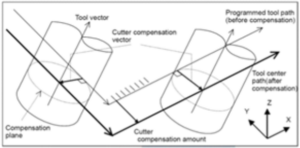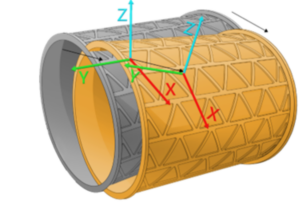What is Adaptive Machining?
Adaptive Machining is a generic industry term used to describe a method that corrects ideal machining motion to the changing conditions found in a real-world machining environment. The changing conditions can be caused by variation in the machine kinematics, setup process, part geometry, cutting tool geometry, and operator behaviors. Anything from a simple tool length offset to a complex 6-degree-of-freedom best-fit correction all fall under the broad definition of “Adaptive Machining”. This article discusses some types of adaptive machining.
Tool Compensation

Basically, anyone that runs a CNC machine is using tool data inputs to adapt the tool path. This could be as simple as inputting a tool length that adjusts the driven point of the spindle to the tip of the tool, to a bit more complex cutter diameter compensation that compensates for a tool diameter that is of a different size than what it was nominally programmed to be. These are simple types of adaptive machining that most machinists use every day.
Work Coordinate Compensation

Every CNC machine uses a work coordinate system to dictate where the zero position of the CNC program is. The operator will typically set this coordinate to a known position on the stock part. If the operator finds their parts are running a little off in one direction or another, they can make a slight adjustment of the work coordinate to compensate. In some cases, they may be able to adjust the rotary position as well. Although this is a bit tougher. A probe can help automate this a bit by allowing the operator to run a simple probing routine that will automatically set the X, Y, and Z linear position of the part on the machine. Some probing routines possess the capability to adjust the rotary positions to square the part to the coordinate system. At most this type of compensation can correct for five degrees of freedom. Although more than three can get complex.
6 Degrees of Freedom Work Piece Alignment

In the past a machinist would load a part into a fixture, and then attempt to align the part by loosening a clamp bumping the part a bit then retightening the clamp. They may add some shims here or there, but overall, it is a labor-intensive process. Automatic work piece alignment allows the machine to use a probe or other measurement device to find the parts full 6 degree of freedom location relative to where the part is supposed to be nominally located. Then an alignment can be applied that corrects machine movement to cut the part correctly where it actually sits rather than where it was programmed to sit. For the best results this process is made to be iterative, so the part is measured, the location updated and then measured again in sequence to ensure the best alignment is achieved.
Coordinate Measuring Machines (CMMs) almost always use an iterative alignment to find the part. The machine’s programming does not rely on the operator to accurately load the part to within a very tight tolerance but instead automatically find the alignment of the part and adjusts how it measures the part based on the part’s real time location.
Fixturing cast, forged, or composite parts on a CNC machine is a difficult proposition. Using an automatic alignment program can allow for automatic alignment of parts live on the machine without any operator intervention. This simplifies your labor demand and your fixturing complexity.
Tool Path Morphing
 Morphing is the most advanced and final type we will discuss today. Tool path morphing allows a CNC machine to autonomously measure a part and automatically morph the tool path to follow the part on the machine. When a small chamfer needs to be applied to a long, flimsy part. With tool path morphing the part will be measured and the tool path automatically adapted to follow the edge of the part. Morphing is applied by measuring edges, or full surfaces. Processes that were previously only able to be accomplished by the hand of a skilled operator can now be automated using a CNC machine.
Morphing is the most advanced and final type we will discuss today. Tool path morphing allows a CNC machine to autonomously measure a part and automatically morph the tool path to follow the part on the machine. When a small chamfer needs to be applied to a long, flimsy part. With tool path morphing the part will be measured and the tool path automatically adapted to follow the edge of the part. Morphing is applied by measuring edges, or full surfaces. Processes that were previously only able to be accomplished by the hand of a skilled operator can now be automated using a CNC machine.
Our Solution
NC Software Solution’s premier product NC Transform (NCT) can automatically link to nearly any CNC giving the user the ability to do any type of adaptive machining discussed in this article quickly and easily. Parts are getting harder to manufacture with ever tighter tolerances. NCT helps make manufacturing tight tolerances achievable while incorporating a high degree of automation. NCT brings a new dimension to industry 4.0 with real time feedback and adaptive control of part machining.

Learn more or schedule a time when our team can walk you through what adaptive machining would look like in your facility.
Video walkthrough NC Transform Ask for a personalized walk-through

